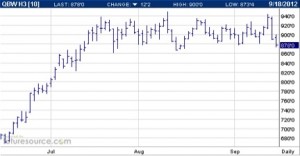After Andrew Borden’s talk on Wednesday, I am intrigued by using weather to predict market movement. Therefore, I intend to spend the next week or so betting on global weather patterns. My split wheat position has treated me well, since losses on my long position were offset by greater gains in my short position. Since the next week will keep me further from a computer, I will remain in the market in this (hopefully) less risky position.
According to Spectrum Commodities [1], China is the world’s largest wheat producer, followed by India, the US, France, and Russia. Canada enters the production landscape as the sixth largest, producing over three times the amount consumed domestically. As China is the largest producer, it makes sense to look at Chinese weather patterns. However, India appears to be a more prominent player in winter wheat, so for trading in December futures contracts, the Indian forecasts are more relevant. [1] According to CNN, weather in India is expected to remain consistent, meaning harvests should be good. Therefore, prices should remain constant, and I will go short an additional contract in spring wheat.
[1] http://www.spectrumcommodities.com/education/commodity/statistics/wheat.html
